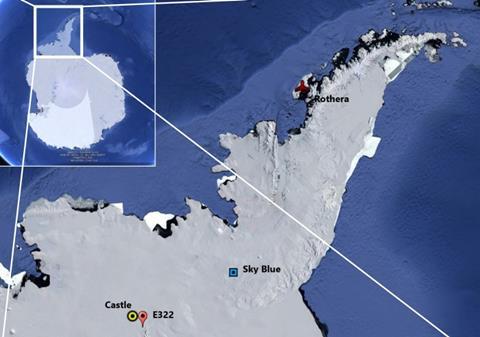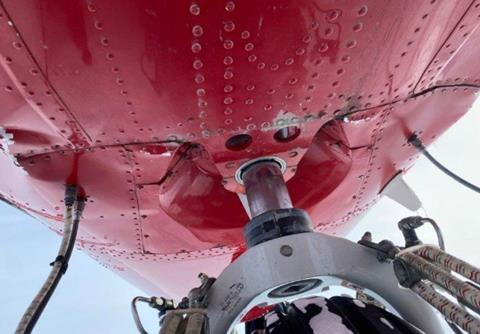Investigators probing a take-off incident in Antarctica which damaged a Viking Air DHC-6-300 have highlighted the difficulty of weighing the risks to personnel against the risk of flight in remote and hostile locations.
The aircraft – fitted with landing skis – had flown to a location called Station E322, close to Mount Lymburner in the Ellsworth mountains.
Prior to departing the station on 23 January last year, the captain prepared an 800m skiway, marked with bamboo poles and aligned with the direction of icy ridges known as sastrugi.
But when the aircraft accelerated along the skiway, the captain felt the right-hand ski sink just before rotation, pulling the nose to the right.

As the aircraft became airborne, a “large impact” was felt on the nose ski, says the UK Air Accidents Investigation Branch.
The captain noticed that the standby artificial horizon indicator showed a 40° bank even though the DHC-6 was level, and one of the primary flight displays’ attitude indicators seemed slightly misaligned. He also noticed dislodged covers around the rudder pedals.
After considering fuel requirements and weather conditions, the captain opted to divert to a fuel depot, known as Castle, which was 40nm away.
He assessed the aircraft damage at Castle, believed no major structures or flight controls were compromised and – aware that Castle was remote and unsupported – decided it was safer to fly back to the British Antarctic Survey station designated Sky Blu, about 300nm away.

Investigators have underscored the “tension” between protecting high-value assets while limiting risk of personnel exposure to hostile environments.
“The operator recognised that there could be rare occasions where decision-making would require a balance to be struck between safety and airworthiness compliance,” it says.
“It concluded there may be circumstances in which it would be appropriate to fly a damaged aircraft if this minimised the exposure of personnel and assets to immediate risks, or if it was required to meet international obligations for the protection of the Antarctic environment.”
The inquiry points out that the captain did not consult the chief pilot regarding the decision to fly to Sky Blu, where the aircraft landed without further incident.
It says there was a “strong psychological barrier” to communicating a “nuanced and complicated situation” over satellite phones, although it adds that this decision “missed the opportunity” to discuss the potential threat of further damage to the aircraft occurring during the subsequent cruise flight.

Examination of the aircraft at Sky Blu found damage to the forward bulkhead and the fairing around the nose-gear, and the captain noted that it “appeared to be worse” than he had observed at Castle.
Neither occupant of the DHC-6, a 1982 airframe registered VP-FBC, was injured.
Investigators found the departing aircraft had struck sastrugi adjacent to the skiway, but could not determine the cause of the deviation. “Conditions in the Antarctic, with its absence of topographical features, monochrome landscape and low contrast environment, can make it difficult to detect lateral movement,” says the inquiry.
It adds that the operator took safety measures including adopting use of low-orbit satellites for communication, which has improved quality and reliability, and developing a checklist to guide decision-making processes when recovering damaged aircraft from remote locations.


























